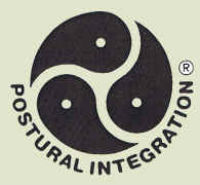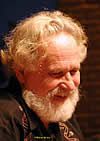POSTURAL INTEGRATION (1960), a body/mind work
Postural Integration supports you in dealing with the challenges in your life in a more creative manner. The uniqueness of this method lies in the simultaneous integration of deep tissue and breath work, body movement and awareness, as well as emotional expression. It enables you to come more into the moment to experience and create your life.
(Sessions are from 1:45 to 2 hours depending on the therapist. Optimal session frequency is about once a week or twice a month.)
What are the 4 Principles of PI?
1. Deep Tissue Body Work to free up tension held in the body
2. Emotional Work to release old memories stored in the tissue
3. Energy Work to take the movement to a more subtle level
4. Integration to bring all the movement into the current moment.
Meaning of Logo
Let’s look at the logo, above, to understand the depth and breadth of PI. The three drops of the elements of earth fire, water – is an ancient symbol in Taoism meaning “balanced power”. It is the goal of Postural Integration to reach greater harmony and balance within the whole organism of a human being.
“Posture” here stands for the way we hold our bodies as well as for the way we stand in the world around us by our actions. “Integration” here means “completion”, it has its roots in Latin and implies the meaning “undamaged, unspoiled”. Thus POSTURAL INTEGRATION (PI) means: restoration of an unspoiled posture (posture in every sense) and thereby integration into a greater whole.
….more details
Jack Painter, creator of Postural Integration,
transitioned June 28, 2010 in Mill Valley, USA at the age of 76.
Jack-Painter-Obituary
Jack’s lifetime of work has been recognized by the European Association of Psychotherapy (EAP), Vienna, Austria, in 2011 with their highest award.
Postural Integration (PI)® was originally developed in the 1960’s by Jack Painter, Ph.D., a former Professor at the University of Miami. He developed PI after many years of self-exploration in the fields of humanistic psychology, deep massage, gestalt therapy, acupressure and the Five Elements system, and especially with Reichian therapy in combination with the work and theories of Ida Rolf. Postural Integration is taught and practiced in Europe, USA, Canada, Mexico, South Africa and Australia. Postural Integration trainers are organized within the International Council of PsychoCorporal (Bodymind) Integration Trainers (ICPIT).
Practitioners of Postural Integration (PI)® have completed a 3-year professional training with a minimum of 700 hours according to the requirements of ICPIT including the theory and practice of:
Anatomy; physiology; applied pathology; body and movement awareness; deep myofascial release and organization; energetic and breath therapy; the natural energy cycle; body reading and dialogue; therapeutic touch, contact and boundaries; verbal and non-verbal communication skills; developmental processes; character styles; the nature of charging and discharging energy; emotional release and integration; body transference and counter-transference; and a supervised internship. They are trained to work in a respectful and interactive manner with their clients. They bring into the relationship with their client professional knowledge and experience and the ability to appropriately share their personal feelings and attitudes.
Order: Transformation of the Self with Bodymind Integration,
Copyright 2012 by Herbert W. Holzinger, Berlin
(editors: Rita Erken & Bernhard Schlage),
a book, in German, about Postural Integration dedicated to Jack Painter.
(You will be taken to the German Amazon.com site. It is only available from there.)
There are 10 self-learning sessions in the Postural Integration Process divided into the following stages:
Releasing Stage – Sessions 1 -7
Integration Stage – Session 8, 9 & 10 (and maybe more)
What is the focus of Sessions 1 – 7 of the Releasing Stage?
Phase 1 – Sessions 1 & 2
This phase initiates the work through the superficial fascia (fatty and denser subcutaneous layers) which surrounds all groups of muscles, to ‘fluff’ up and lubricate the layers to give more space and to re-hydrate the tissue. Common feelings experienced can be “I can breathe better”, “Wow, it’s an excitement!”
Session 1* is usually focused at the upper body, opening the chest, helping with the breath and connecting the arms to the chest.
Session 2* works with the feet and legs, beginning to explore how you stand on your feet; Where is your weight focused? The goal is a horizontal axis between the ends of the leg bones at the ankle.
*These 2 sessions are interchangeable.
Phase 2 – Session 3
The focus of this phase is a little deeper on the superficial subserous fascia, the fascia that surrounds each muscle, to connect the bottom & top of the body, working to elongate the torso, separate the waist from the rib cage and work with the shoulders to reposition the arms.
Phase 3 – Session 4, 5 & 6
Now that we have opened and connected the top and bottom of the body, we work to free up tension in the pelvis by working on the deep subserous fascia, the fascia in between each muscle.
Session 4 – We work on the lower/front pelvis from inside the foot up to the adductors inside the thighs.
Session 5 – We work on the front/upper part of the pelvis and abdomen up to the sternum, including the psoas muscle.
Session 6 – We work on the lower and upper back of the pelvis from the outer foot all the way up the backs of the legs, buttocks and sacrum to the shoulder blades.
Phase 4 – Session 7
In this session we work to release the head and neck.
What is the focus of the Integration Phase of PI Sessions 8, 9 & 10?
The focus of these sessions is to integrate the different divisions of the body/mind that have been opened, worked and released in the prior sessions for a coherent whole in the present. These divisions are as follows: Front/Back, Left/Right, Center/Periphery and Top/Bottom.
No. The strokes used in Postural Integration work to open and unbind the connective tissue at a deep level. Lubricants don’t facilitate this depth of tissue opening. Rather, the practitioner waits until the tissue opens up under the stroke in combination with the charging through the breath, body gestalt and fine energy work.
It can be. It all depends on your attitude. The more you embrace the exploration of your body/mind in the different sessions- putting your limits, realizing and understanding that the uncomfortable sensations you are experiencing are merely your resistance to old tension- the less you will be stuck on the ‘pain’ and the more you will pass through to a different experience. As well, the charging we do with the breath, the awareness created by the body gestalt and the fine energy work will help you to release and open to the new rather than holding on to ‘stuckness’ from the past.
What happens in a PI Session?
The normal structure of a session is as follows:
1. “Hello, what’s happening in your body?”
2. Body reading based on which session: If you were receiving Session 7, for example, the head and neck, questions about what you feel about your head/neck would be normal; “Does your head feel straight, tilted, flat, set back on the neck, round”, etc. This often leads to the next part—-
3. Body Gestalt: Based on your answers, a foreground/background awareness in your body is developed. For example, if you feel your head as tilted, you may be asked to exaggerate the tilt and let the tilt have a voice. “What does it have to say; what does it feel?” Then another part of the body that forms the background to the tilt is explored. What does it feel when the tilt expresses itself? What does it want to say, etc. The therapist and you are working towards both parts of you connecting and communicating with each other and working together.
4. Charging: Once the body gestalt is clearly developed, you lie down and both of you work to bring up the charge in the body using the appropriate kind of breath for how you normally breathe- more chest or abdomen, shallow or deep, etc. This may include different exercises/movements, such as closing the eyes on the inhale or opening them on the exhale, moving the legs from side to side, reaching out with your arms and/or making funny sounds, for example. This part can be quite fun. As well, acupressure is used on specific points depending on which session and/or the meridians are brushed to help bring up the charge. If appropriate, the therapist may ask you questions relating to the body gestalt foreground/background that was established earlier to help with the overall charging.
5. While you continue to breathe the therapist then begins the appropriate strokes for the session asking you to make specific movements with the different strokes. At the same time he/she may weave in the body gestalt or the primary theme you wanted to work on in the sessions. You may be asked to stand up periodically for you to notice the difference between the side of the body that’s been worked versus the side that hasn’t.
6. After the strokes are finished, the end of the session is normally ended quietly with a short meditation, visualization, application of tuning forks and/or energy technique- whatever is appropriate.
7. Before leaving you stand to have an awareness of what you are feeling after the session and you may be asked to be aware of posture or breathe, etc. during the week until our next session. In the sessions Arden and Jack Wilken did, they also suggested, where appropriate, listening to some of the INNER SOUND therapeutic music to continue the process of change between sessions.
Postural Integration supports you in dealing with the challenges in your life in a more creative manner. The uniqueness of this method lies in the simultaneous integration of deep tissue and breath work, body movement and awareness, as well as emotional expression. It enables you to come more into the moment to experience and create your life.

